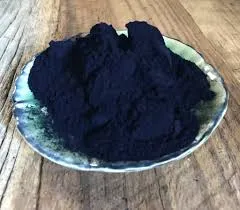china indigo dye for fabric
The Rich Tradition of Indigo Dyeing in China
Indigo dyeing has a storied history in China, particularly known for its stunning blue hues and the intricate patterns that can be created on fabric. This ancient practice is not just a method of coloring textiles; it embodies a deep cultural significance and represents the profound connection between nature and craftsmanship in Chinese society.
Indigo dye is primarily derived from the leaves of the indigo plant, mainly *Indigofera tinctoria*. The process of extracting and applying indigo dye has been perfected over centuries, showcasing the remarkable ingenuity of Chinese artisans. Traditionally, the dyeing process involves fermenting the leaves, allowing the creation of a blue pigment known as indigo. This pigment can produce a range of shades from light sky blue to deep navy, depending on how many times the fabric is dipped into the dye bath.
The Rich Tradition of Indigo Dyeing in China
The dyeing process itself is a fascinating journey. After the fabric is treated and prepped, it is immersed in the indigo dye, usually multiple times. Each dip allows for the fabric to absorb more of the rich color, creating depth and complexity. A unique characteristic of the indigo dyeing process is the transformation of color; when fabric is first pulled from the dye bath, it appears green. Only after exposure to air does the vibrant blue reveal itself, enchanting dye artists and consumers alike.
china indigo dye for fabric

Moreover, the use of indigo dye extends beyond just color aesthetics. In traditional Chinese culture, blue is often associated with healing and protection. Fabrics dyed with indigo are believed to ward off negative energies and promote good health, linking the color philosophy directly to the personal and societal well-being of the community.
In recent years, there has been a resurgence of interest in natural dyes, spurred by a global movement towards sustainability and eco-friendly practices. As a result, indigo dyeing has seen a revival among younger generations and artisans eager to preserve traditional techniques while experimenting with modern designs. This blending of old and new not only preserves China's rich heritage but also adapts it for contemporary fashion.
In addition, many workshops and studios across China now offer indigo dyeing experiences for tourists and locals alike, providing them with a hands-on opportunity to engage with the craft. These workshops often emphasize the storytelling aspect of indigo dyeing, explaining its significance in social rituals and daily life, thus enriching participants’ understanding of Chinese culture.
As consumers increasingly appreciate artisanal and sustainably crafted products, indigo dyed fabrics have found a place in international markets. Designers around the world are incorporating these unique textiles into their collections, allowing a broader audience to experience the beauty and heritage of Chinese indigo dyeing.
In conclusion, indigo dyeing in China is much more than just a method of fabric coloring; it is a testament to the country's rich cultural tapestry and a symbol of resilience and creativity that transcends generations. As this age-old craft continues to evolve, it reminds us of the beauty of tradition and the importance of preserving cultural heritage in a rapidly changing world.
-
The Timeless Art of Denim Indigo Dye
NewsJul.01,2025
-
The Rise of Sulfur Dyed Denim
NewsJul.01,2025
-
The Rich Revival of the Best Indigo Dye
NewsJul.01,2025
-
The Enduring Strength of Sulphur Black
NewsJul.01,2025
-
The Ancient Art of Chinese Indigo Dye
NewsJul.01,2025
-
Industry Power of Indigo
NewsJul.01,2025
-
Black Sulfur is Leading the Next Wave
NewsJul.01,2025

Sulphur Black
1.Name: sulphur black; Sulfur Black; Sulphur Black 1;
2.Structure formula:
3.Molecule formula: C6H4N2O5
4.CAS No.: 1326-82-5
5.HS code: 32041911
6.Product specification:Appearance:black phosphorus flakes; black liquid

Bromo Indigo; Vat Bromo-Indigo; C.I.Vat Blue 5
1.Name: Bromo indigo; Vat bromo-indigo; C.I.Vat blue 5;
2.Structure formula:
3.Molecule formula: C16H6Br4N2O2
4.CAS No.: 2475-31-2
5.HS code: 3204151000 6.Major usage and instruction: Be mainly used to dye cotton fabrics.

Indigo Blue Vat Blue
1.Name: indigo blue,vat blue 1,
2.Structure formula:
3.Molecule formula: C16H10N2O2
4.. CAS No.: 482-89-3
5.Molecule weight: 262.62
6.HS code: 3204151000
7.Major usage and instruction: Be mainly used to dye cotton fabrics.

